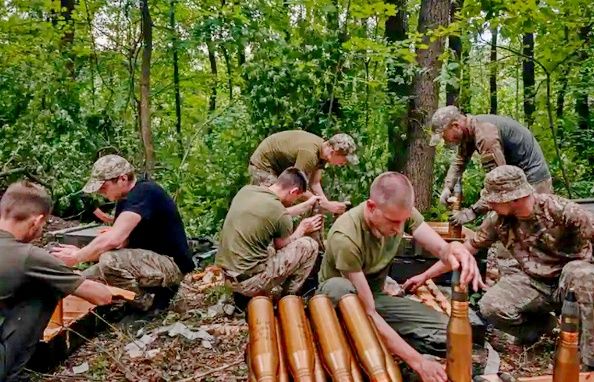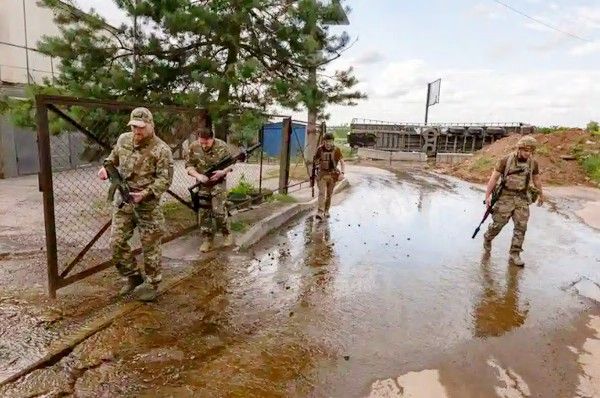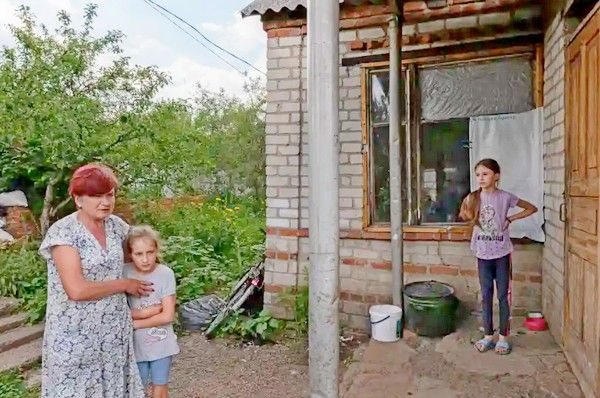‘The enemy is planning something’: Kharkiv fears new Russian attack

The Guardian - Tue 28 Jun 2022 05.00 BST by Pjotr Sauer and Jelle Krings in Kharkiv
Putin’s advance on Ukraine’s second city was halted in March, but its defenders sense another offensive is looming. In the thick pine forests on the outskirts of Kharkiv, Konstantin was watching over his troops as they inspected their weapons.
Some were greasing shells from the 1970s, preparing them to be used for an even older 57 mm AZP S-60 anti-aircraft gun developed just after the second world war.
Since the invasion, the West has spent billions in military support to help Ukraine fend off the Russian offensive, most recently shipping the advanced Himars rocket systems to Kyiv.
But in the trenches near Ukraine’s second-biggest city, those arms deliveries felt a world away.
“Here, we simply have not seen any western weapons. All we can rely on is our Soviet-era weapon stock,” said Konstantin, an imposing figure who leads the 228th battalion of the 127th brigade of the territorial defense forces.
For four months now, Konstantin and his territorial defense formation – a unit that is part of the military but mostly made up of inexperienced volunteers – have been fighting against Russian forces just a few miles away from Kharkiv.
“Based on our intelligence, the Russians are planning something near Kharkiv,” the commander said.

“We will win either way,” he quickly added.
“With western weapons, less of our boys would have to die for victory.”
‘Every day, they test our lines’
Located 25 miles from the Russian border, Kharkiv has great strategic importance as the gateway to the east of Ukraine. Russia tried to conquer it during the first week of the war, sending columns of tanks and military police units towards the city.
By the end of February, Kharkiv was very nearly surrounded on three sides, with tanks, planes, and artillery firing on the city. Initially, it appeared that Russian forces would march directly into central Kharkiv. But Ukrainian forces regrouped, and in the first weeks of March, they halted the Russian advance.
What followed were two Ukrainian counter-offensives, first in late March and then in May, which pushed Russian forces away from the outskirts of the city. At the same time, Ukraine also recaptured some of the burnt-out villages that Moscow had occupied.
Apart from a short lull some three weeks ago, Russia’s relentless shelling of the city, coming mostly out of the Russian border town of Belgorod, never stopped, destroying more than 2,000 buildings and killing more than 900 civilians in the process, according to the regional governor, Oleh Synehubov.
Over the last two weeks, the city has seen some of the heaviest bombardments since the start of the war, and there are fears among senior Ukrainian officials, as well as local military heads, that a renewed Russian offensive is looming.
“We believe Russia could launch a new attack in the near future,” said Andrii Mogyla, a Ukrainian soldier who declined to say in which unit he served, citing secrecy concerns.
Mogyla, who was speaking to the Guardian from a makeshift office at a former language school, said he first fought on the frontlines but added he was soon moved to a different unit to “analyze” the war, given his background as a software developer.
“The Russians usually start with rocket attacks, then heavy artillery comes in, and then they move in with tanks and infantry. We see the first part already happening,” Mogyla said.
Equally concerning, according to Mogyla, were the recent bits of intelligence from “western partners” that his team received, including satellite images that showed Russia massing new troops and military hardware on the frontlines near Kharkiv.
Pointing to his table screen, Mogyla showed images that, he said, indicated a recent massing of forces on the eastern side of Kharkiv near the Russian-occupied village of Shevchenkove. According to Mogyla, about 100 army units, including 50 tanks and eight battalions, were moved there three weeks ago.
“We can’t be certain when, but in the near future, they will attack,” he said, calling for the west to step up its delivery of heavy artillery weapons and drones for reconnaissance.

“In this part of Ukraine, we are even more outgunned than in the Donbas. Ukraine has one artillery piece to 15 Russian artillery pieces,” he said.
Stopping Kharkiv from getting shelled, Mogyla said, was a particularly hard task as it is only 25 miles from the border.
Analysts have pointed out that it would be impossible to stop the Russian bombardment without counter-battery fire hitting Russia, which Ukraine has promised not to do with newly sent western weapons.
The sound of Russia’s military superiority can be heard in Kharkiv almost every night when Russia launches its Iskander and other rockets from across the border. The city then goes eerily dark, so as to not provide Russian planes or artillerists with targets.
Over the last weeks, the shelling, which has largely hit residential areas, has killed more than 20 civilians in the region, including an eight-year-old girl.
“The enemy is planning something, they are gathering troops. But we do not know what their timeline is,” said Konstantin, the commander, speaking this time from the nuclear bunker of the Kharkiv regional state administration building, which was hit by an airstrike on the morning of 1 March.
“Every day, they test our lines. They sent in reconnaissance units to see where our weaknesses are, but we have been very successful in repelling them.”
And while both Konstantin and Mogyla said evidence pointed to a new Russian attack in the region, they insisted that Moscow did not have the capability to capture the city of Kharkiv.

Despite continued advances in eastern Ukraine, including the capture of the key city of Sievierodonetsk, western intelligence similarly predicts that the Russian military would need to regroup before it could engage in a major new offensive across the country.
Instead, without new western weapons for Ukraine, the battle around Kharkiv was likely to drag on for months, if not years, said Mogyla.
“Both parties have started to defend well, and not much progress is being made by either side.”
At the same time, Ukrainian officials warn that brigades such as that led by Konstantin could soon be running out of their Soviet-era weaponry as a result of what many believe to be an eight-year Russian clandestine campaign to bomb key munitions depots across eastern Europe with weapons destined for Ukraine.
‘We have nowhere else to go’
Fear of a Russian return, however, still dominates the mood in the previously occupied villages outside of Kharkiv.

In Malaya Rohan, a small village about 10 miles east of the city, memories of the Russian occupation feel fresh.
Tanks first rolled into the village on 25 February, taking much of the population by surprise.
“At first, we thought those were our guys holding a military practice. It all happened so fast,” said Dmitry, who was clearing his small plot of land of the debris left behind by the Russian soldiers.
The proximity to the Russian border meant that Dmitry and others did not have time to evacuate, and many in the village spent the month under Russian occupation in their basements, only occasionally coming out for food and water.
Russian troops took over some of the houses in Malaya Rohan, including Dmitry’s, where he said they looted and stole “everything, until the very last spoon”.

The village still feels – and smells – like a war zone, despite having been liberated from occupation at the end of March.
During a visit by the Guardian to one burnt-out house that had been used by the occupying troops, Russian army clothes, playing cards and even gift cards from Moscow could be found.
Ksenia, an elderly woman who returned to Malaya Rohan last week, said that many in the village were worried about a new Russian advance. But those whose houses were not destroyed had little option but to return.
“We have nowhere else to go, we were sharing a one-bedroom flat with three families. This was our only home, and we need to rebuild it,” she said.

In Ksenia’s summer garden, next to an apple tree, the burnt carcass of a Russian tank had replaced the picnic table.
“I am still getting used to this uninvited guest in my backyard,” she said.
Commentary:
HUMAN SYNTHESIS
COPYRIGHTS
Copy & Paste the link above for Yandex translation to Norwegian.
WHO and WHAT is behind it all? : >
The bottom line is for the people to regain their original, moral principles, which have intentionally been watered out over the past generations by our press, TV, and other media owned by the Illuminati/Bilderberger Group, corrupting our morals by making misbehavior acceptable to our society. Only in this way shall we conquer this oncoming wave of evil.
All articles contained in Human-Synthesis are freely available and collected from the Internet. The interpretation of the contents is left to the readers and does not necessarily represent the views of the Administrator. Disclaimer: The contents of this article are of the sole responsibility of the author(s). Human-Synthesis will not be responsible for any inaccurate or incorrect statement in this article. Human-Synthesis grants permission to cross-post original Human-Synthesis articles on community internet sites as long as the text & title are not modified.
HUMAN SYNTHESIS